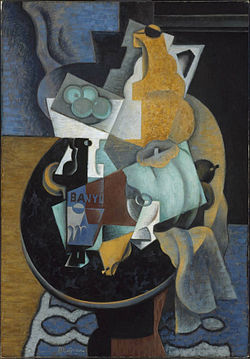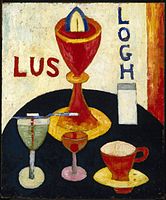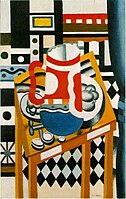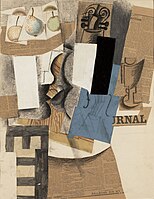
Henri Matisse, Still Life with Geraniums (1910), Pinakothek der Moderne, Munich, Germany
Henri Matisse reduced the rendering of still-life objects even further to little more than bold, flat outlines filled with bright colours. He also simplifyied perspective and introducing multi-colour backgrounds. In some of his still-life paintings, such as Still Life with Eggplants, his table of objects is nearly lost amidst the other colourful patterns filling the rest of the room. Other exponents of Fauvism, such as Maurice de Vlaminck and André Derain, further explored pure colour and abstraction in their still life.

Jean Metzinger, Fruit and a Jug on a Table (1916), oil and sand on canvas, 115.9 x 81 cm, Museum of Fine Arts, Boston
Adapting Cézanne’s shifting of planes and axes, the Cubists subdued the colour palette of the Fauves and focused instead on deconstructing objects into pure geometrical forms and planes. Between 1910 and 1920, Cubist artists like Pablo Picasso, Georges Braque, and Juan Gris painted many still-life compositions, often including musical instruments, bringing still life to the forefront of artistic innovation, almost for the first time. Still life was also the subject matter in the first Synthetic Cubist collage works, such as Picasso's oval "Still Life with Chair Caning" (1912). In these works, still-life objects overlap and intermingle barely maintaining identifiable two-dimensional forms, losing individual surface texture, and merging into the background—achieving goals nearly opposite to those of traditional still life. Fernand Léger’s still life introduced the use of abundant white space and coloured, sharply defined, overlapping geometrical shapes to produce a more mechanical effect.

Giorgio Morandi (1890–1964), Natura Morta (1956), oil on canvas, private collection
Rejecting the flattening of space by Cubists, Marcel Duchamp and other members of the Dada movement, went in a radically different direction, creating 3-D "ready-made" still-life sculptures. As part of restoring some symbolic meaning to still life, the Futurists and the Surrealists placed recognizable still-life objects in their dreamscapes. In Joan Miró’s still-life paintings, objects appear weightless and float in lightly suggested two-dimensional space, and even mountains are drawn as simple lines. In Italy during this time, Giorgio Morandi was the foremost still-life painter, exploring a wide variety of approaches to depicting everyday bottles and kitchen implements. Dutch artist M. C. Escher, best known for his detailed yet ambiguous graphics, created Still life and Street (1937), his updated version of the traditional Dutch table still life. In England Eliot Hodgkin was using tempera for his highly detailed still-life paintings.When 20th-century American artists became aware of European Modernism, they began to interpret still-life subjects with a combination of American realism and Cubist-derived abstraction. Typical of the American still-life works of this period are the paintings of Georgia O'Keeffe, Stuart Davis, and Marsden Hartley, and the photographs of Edward Weston. O’Keeffe’s ultra-closeup flower paintings reveal both the physical structure and the emotional subtext of petals and leaves in an unprecedented manner.
In Mexico, starting in the 1930s, Frida Kahlo and other artists created their own brand of Surrealism, featuring native foods and cultural motifs in their still-life paintings.
Starting in the 1930s, abstract expressionism severely reduced still life to raw depictions of form and colour, until by the 1950s, total abstraction dominated the art world. However, pop art in the 1960s and 1970s reversed the trend and created a new form of still life. Much pop art (such as Andy Warhol's "Campbell's Soup Cans") is based on still life, but its true subject is most often the commodified image of the commercial product represented rather than the physical still-life object itself. Roy Lichtenstein’s Still Life with Goldfish Bowl (1972) combines the pure colours of Matisse with the pop iconography of Warhol. Wayne Thiebaud’s Lunch Table (1964) portrays not a single family’s lunch but an assembly line of standardized American foods.
The Neo-dada movement, including Jasper Johns, returned to Duchamp’s three-dimensional representation of everyday household objects to create their own brand of still-life work, as in Johns’ Painted Bronze (1960) and Fool’s House (1962). Avigdor Arikha, who began as an abstractionist, integrated the lessons of Piet Mondrian into his still lifes as into his other work; while reconnecting to old master traditions, he achieved a modernist formalism, working in one session and in natural light, through which the subject-matter often emerged in a surprising perspective.
A significant contribution to the development of still-life painting in the 20th century was made by Russian artists, among them Sergei Ocipov, Victor Teterin, Evgenia Antipova, Gevork Kotiantz, Sergei Zakharov, Taisia Afonina, Maya Kopitseva, and others.
By contrast, the rise of Photorealism in the 1970s reasserted illusionistic representation, while retaining some of Pop's message of the fusion of object, image, and commercial product. Typical in this regard are the paintings of Don Eddy and Ralph Goings.
Twentieth-century paintings

Henri Matisse (1869–1954), Dishes and Fruit (1901), Hermitage Museum, St. Petersburg, Russia
| 
Odilon Redon (1840–1916), Flowers(1903)
| 
Georges Braque (1882–1963), Violin and Candlestick (1910), San Francisco Museum of Modern Art
| 
Juan Gris (1887–1927), Nature morte (1913), Museo Thyssen Bornemisza
|
|---|---|---|---|

Marsden Hartley (1877–1943), Handsome Drinks (c. 1916), Brooklyn Museum
| 
Fernand Léger (1881–1955), Still Life with a Beer Mug (1921), Tate
| 
Pablo Picasso, Compotier avec fruits, violon et verre (1912)
|
A still life (plural: still lifes) is a work of art depicting mostly inanimate subject matter, typically commonplace objects which are either natural (food, flowers, dead animals, plants, rocks, shells, etc.) or man-made (drinking glasses, books, vases, jewelry, coins, pipes, etc.).
With origins in the Middle Ages and Ancient Greco-Roman art, still-life painting emerged as a distinct genre and professional specialization in Western painting by the late 16th century, and has remained significant since then. A still-life form gives the artist more freedom in the arrangement of elements within a composition than do paintings of other types of subjects such as landscape or portraiture. Still life, as a particular genre, began with Netherlandish painting of the 16th and 17th centuries, and the English term still life derives from the Dutch word stilleven. Early still-life paintings, particularly before 1700, often contained religious and allegorical symbolism relating to the objects depicted. Some modern still-life work breaks the two-dimensional barrier and employs three-dimensional mixed media, and uses found objects, photography, computer graphics, as well as video and sound.
The term includes the painting of dead animals, especially game. Live ones are considered animal art, although in practice they were often painted from dead models. The still-life category also shares commonalities with zoological and especially botanical illustration, where there has been considerable overlap among artists. Generally a still life includes a fully depicted background, and puts aesthetic rather than illustrative concerns as primary.
Still life occupied the lowest rung of the hierarchy of genres, but has been extremely popular with buyers. As well as the independent still-life subject, still-life painting encompasses other types of painting with prominent still-life elements, usually symbolic, and "images that rely on a multitude of still-life elements ostensibly to reproduce a 'slice of life'". The trompe-l'œil painting, which intends to deceive the viewer into thinking the scene is real, is a specialized type of still life, usually showing inanimate and relatively flat objects.
Source From Wikipedia
没有评论:
发表评论